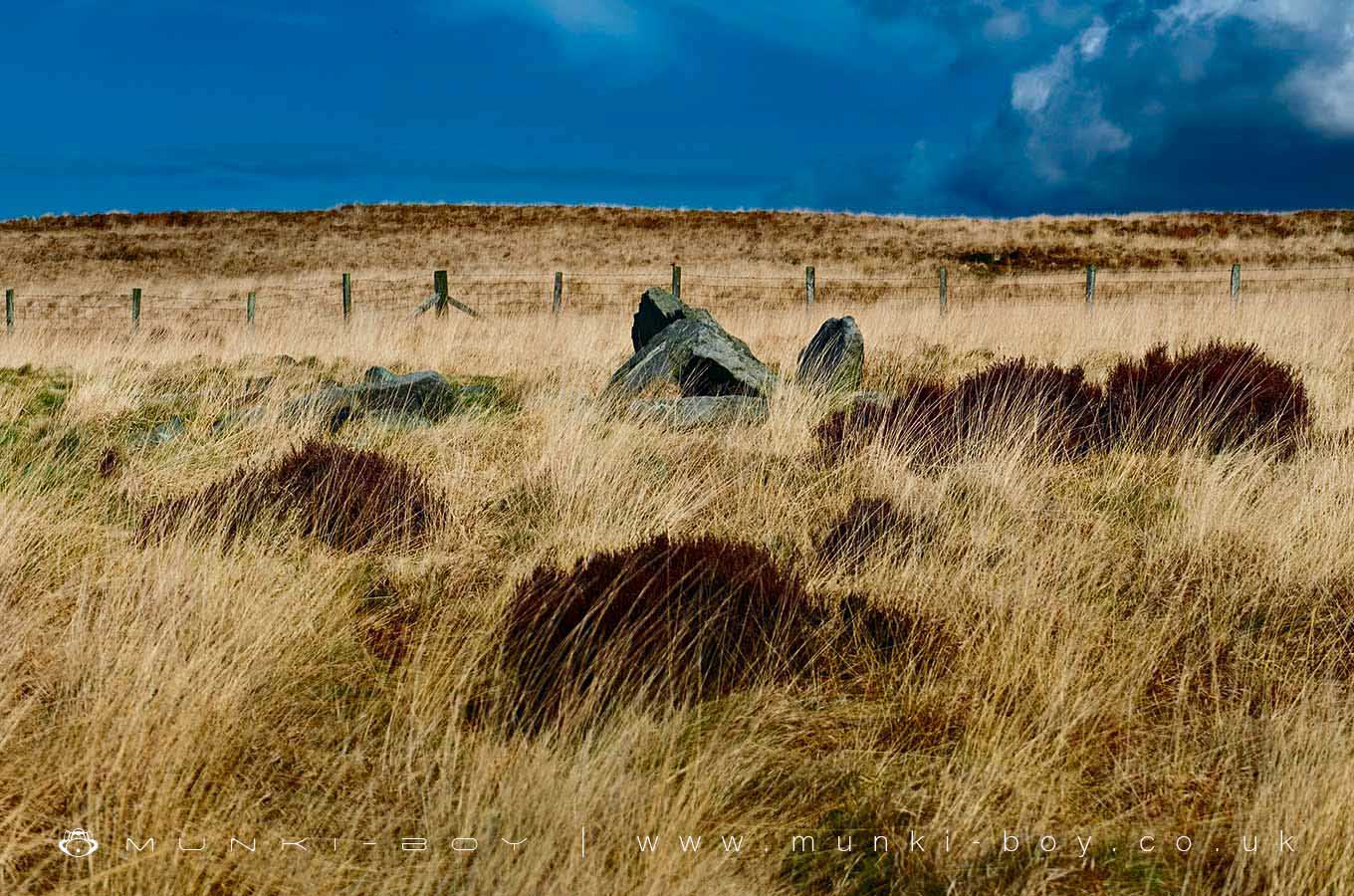
Pikestones Chambered Long Cairn by munki-boy
Pikestones Chambered Long Cairn
Pikestones Chambered Long Cairn
Once a large burial mound, Pikestones was excavated down to ground level in the past, which is now regarded as an overly enthusiastic effort. If more of the barrow had been left intact it could have been analysed using modern technology.
Pikestones is not difficult to reach, just a short walk from the tiny parking area at Jepson’s Gate. The ground on the way up can be a bit boggy.
Pike Stones chambered long cairn Scheduled Monument
The monument includes the Pike Stones Neolithic chambered long cairn. It is located on a low ridge on a lower extension of the main gritstone mass of Anglezarke Moor and commands extensive views in all directions except the north east. It includes a chambered long cairn which has a low elongated mound of gritstones and glacial erratics up to 0.4m high which is aligned almost north-south and measures a maximum of 48m long by 19m wide at the northern end and 14m wide at the southern end, but widens at the centre due to a combination of disturbance and slippage to approximately 29m. At the wider northern end the cairn consists of a double wall, the outer of slightly larger stones than the inner, both curving across the northern end and inwards to form an entrance or forecourt. This entrance gives access into the cairn’s interior where, towards the northern end, there are remains of an inner burial chamber slightly out of alignment with the cairn’s longer axis. This chamber is constructed of large gritstone slabs, measures c.4.5m long by 1m wide, and would originally have been roofed with horizontal slabs and covered by the gritstone rubble of the cairn. The surviving slabs are five in number and measure 1.6m-2.7m long by 0.15m-0.45m thick and stand to a maximum height of 1.3m. There are two at the east side, one at the west side, a transverse slab at the inner end and what is probably a fallen capstone. Around the inner end of this chamber is a roughly circular area of stones approximately 25m in diameter and larger than those in the general matrix of the cairn. This feature suggests the original presence of some form of circular structure behind the chamber or around part of it similar to that found at chambered cairns in the Gloucestershire area. In the southern part of the cairn some regularities in the stones can be seen; some, in lines parallel to the long axis, are perhaps constructional details, but others, in particular a group near to the eastern edge, are thought to represent some form of internal structure which is not presently understood.
Chambered tombs are funerary monuments constructed and used during the Early and Middle Neolithic periods (3400-2400 BC). They comprise linear mounds of stone covering one or more stone-lined burial chambers. With other types of long barrow they form the burial places of Britain’s early farming communities and, as such, are amongst the oldest field monuments surviving visibly within the present landscape. Where investigated, chambered tombs appear to have beenused for communal burial, often with only parts of the human remains having been selected for interment. The number of burials placed within the tombs suggests they were used over a considerable period of time and that they were important ritual sites for local communities. Some 300 chambered tombs are recorded in England. As one of the few types of Neolithic structure to survive as upstanding monuments, and due to their rarity, their considerable age and longevity as a monument type, all chambered tombs are considered to be nationally important. Despite removal of much of the covering cairn and evidence of modern surface disturbance, Pike Stones chambered long cairn survives reasonably well. It retains an internal burial chamber and other constructional features including evidence for the entrance or forecourt which provided access into the monument. Being the only known chambered long cairn in Lancashire, Pike Stones is an unusual outlier to the main regional groupings of such megalithic monuments; these lying mainly further south, in Wales or the Cotswold-Severn areas, or further north in south western or western Scotland.
SCHEDULING HISTORY
Monument included in the Schedule on 12th June 1959 as:
COUNTY/NUMBER: Lancashire 120 NAME: Pike Stones The reference of this monument is now:
NATIONAL MONUMENT NUMBER: 23731
NAME: Pike Stones chambered long cairn
SCHEDULING REVISED ON 01st August 1994
Created: 27 November 2016 Edited: 29 November 2023
Pikestones Chambered Long Cairn
Pikestones Chambered Long Cairn LiDAR Map
please wait...
Contains public sector information licensed under the Open Government Licence v3.0
Local History around Pikestones Chambered Long Cairn
There are some historic monuments around including:
Round cairn 280m west of Old Harpers FarmRound Loaf bowl barrow on Anglezarke MoorBretters Farm moated site and two fishpondsPike Stones chambered long cairnRound cairn on Winter HillHeadless Cross, GrimefordMoated site at Arley Hall, Haigh near WiganRound cairn on Noon Hill.





